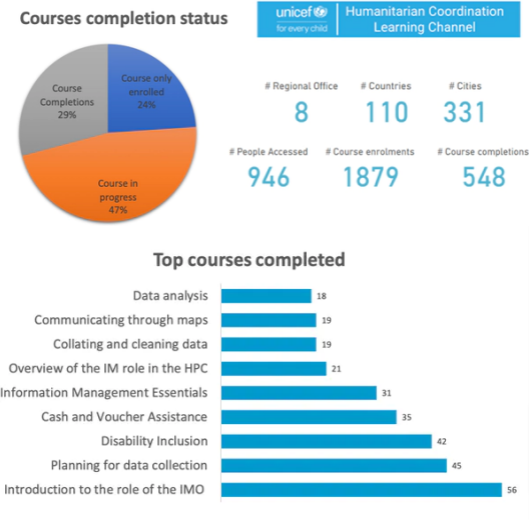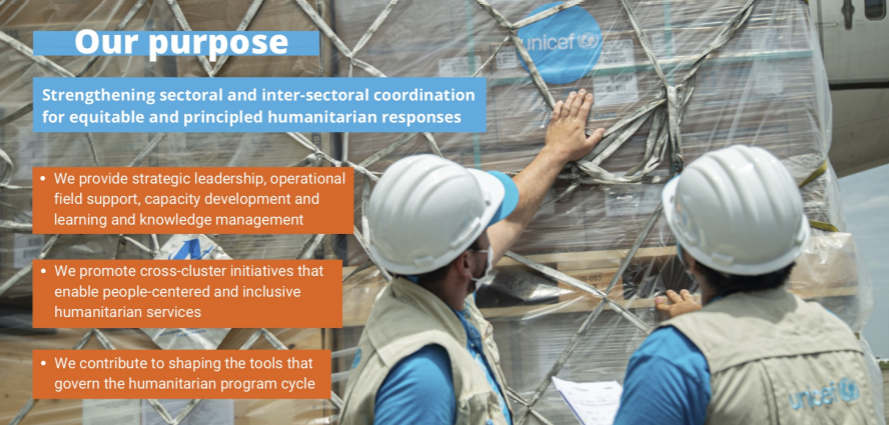STRENGTHENING UNICEF'S ROLE AS CLUSTER LEAD AGENCY
UNICEF holds a unique role as cluster lead/co-lead for the child protection, education, nutrition and WASH sectors. Seven years after the first evaluation, of UNICEF's cluster lead agency role (CLARE II) calls for a stronger execution of cluster lead responsibilities. Detailed actions to ensure implementation of CLARE II recommendations have been defined in an Evaluation Management Response (EMR) and validated by UNICEF’s Executive Board on 16th June.
Implementation will focus on strengthening UNICEF accountability at all levels for its cluster role; prioritizing adequate staffing and funding levels for cluster functions; supporting and maximising collective impact; and ensuring UNICEF’s experiences and tools as CLA support effective humanitarian action through the IASC. Actions in the EMR are already ongoing and will be implemented over the next three years. Watch this short animation video to learn more about CLARE II. The Global Education Cluster has also completed the management response to its co-leadership review with Save the Children, conducted alongside the CLARE II. Read the full CLARE II evaluation report here.
INTERCLUSTER STRATEGIC ALIGNMENT
Three UNICEF-(co)led clusters (WASH, Nutrition and Education) have launched their aligned cluster strategies for 2022-2025. The timing not only aligns with each other, but also with the UNICEF strategic plan, thus allowing for optimal synergies of vision and of effort. All clusters reinstated their focus on supporting high quality coordination on the ground through staffing, capacity building and technical support, but also underscored their focus on partnerships, localization and anticipatory action. The Child Protection Area of Responsibility also touches on these areas, with a timeframe that is fully aligned with the broader Protection
Cluster (2020-2024). Check the clusters' strategies below:

- Global WASH Cluster Strategic Plan 2022-2025
- Global Nutrition Cluster Strategy 2022-2025
- Global Education Cluster Strategy 2022-2025
- Child Protection AoR Strategy 2020-2024
INTER-AGENCY TOOLKIT ON LOCALISATION IN HUMANITARIAN COORDINATION LAUNCHED IN APRIL
The Inter-Agency Toolkit on Localisation in Humanitarian Coordination supports humanitarian coordinators, co-leads and partners to invest in local and national actors’ participation and leadership in coordination in diverse humanitarian settings. Importantly, the toolkit also provides specific resources for local and national actors to strengthen their capacity to influence and play leadership roles in coordination fora.
This toolkit aims to be the go-to resource for localisation across a range of clusters and humanitarian coordination structures, with tools relevant to a wide range of practitioners. The toolkit was developed in a collaborative, inter-agency manner in consultation with key stakeholders from the following groups and agencies: the Global Child Protection Area of Responsibility, the Global Education Cluster, the Global Nutrition Cluster, the Global WASH Cluster, Save the Children, Street Child UK, CLEAR Global, the Inter-Agency Network for Education in Emergencies, country-level coordinators in Nigeria and Bangladesh, and national and local actors who have participated in localisation in coordination initiatives in South Sudan and Iraq. The toolkit will be piloted in four countries in 2022 and is available here: Toolkit on Localisation in Humanitarian Coordination.
HUNDREDS TRAINED THROUGH THE NEW GCCS E-LEARNING PLATFORM
In only three months since the launch of GCCS Information Management e-learning modules in March, the potential of the self-learning approach was made evident: 950 learners from 110 countries, many of them in remote field locations, enrolled in online training. The time and financial resources that would have been required to reach these many people are substantial, confirming that the platform offers a high return on investment and the potential to conduct capacity building at scale. The GCCS vision is to improve access to learning on core aspects of coordination across all clusters, partners, and programme staff, which in turn would allow for more focused and skills-oriented face-to-face trainings. Additional content development will focus on further content for cluster coordinators and senior managers.

REFLECTIONS FROM UKRAINE
Eric Wyss, Deputy Coordinator for Field Support for the Global Child Protection Area of Responsibility, was deployed as part of the Rapid Response Team to Ukraine from 07 March to 16 April, to support humanitarian coordination. We spoke with him about some of the difficulties he observed for colleagues and organizations working in country. He also shared some views on issues that could be addressed by UNICEF as a Cluster Lead Agency to improve efficiencies on the support to countries on coordination.
Q: What is the main role of an RRT (Rapid Response Team) deployee in these circumstances?
To relieve some pressure and bring clarity on the way forward. The initial stages of an emergency are crucial to ensure the right set up, with adequate capacity. Internally, there are competing priorities and multiple moving pieces, on top of the increased pressure to swiftly address all issues while also managing an influx of surge staff. Externally, there is an increase in coordination fora and it is important to know where to invest efforts, and where and how to position the sector. The RRT works in tandem with colleagues on the ground to help them navigate these waters while bringing the kind of expertise needed to add value.
Q: Which aspects about the conditions of people responding to the emergency were particularly significant to you?
Many staff stayed for weeks in hotel rooms with their families and pets, while struggling to find longer term accommodations, and unable to properly rest due to recurrent air-raid alarms. Most have been displaced and are worried about the fate of their dear ones. Colleagues are therefore personally affected by the crisis and remain under elevated levels of uncertainty. Yet, they have led the massive scale-up of the response, revisiting previous strategies to deliver faster in a multilevel and ever more complex emergency.
Q: What is the challenge for organizations taking part to the humanitarian coordination effort?
While the scale and the nature of the conflict changed on February 24th, this is not a new emergency. The Child Protection Sub-Cluster in Ukraine has been active in the East since 2014. Yet the renewed level of international support and the spillover of the confrontation to new geographic areas have brought about significant developments within the coordination landscape. New opportunities also came with many changes: new players, working groups, initiatives, procedures. For example, reporting requirements increased overnight, while organizations on the ground where overwhelmed with the situation and busy scaling up to new areas of coverage. English has also become a central working language. And while the Government has been notable in leading the response (and will remain so), it has also been overstretched to play a more prominent role across the cluster system.
Q: Based on this experience, how could we continue improving support to country offices during emergency scale-up activations? What issues do you think should be addressed?
First, UNICEF-led clusters and the CP AoR undertake parallel discussions with the Country Office on similar topics as other parts of the organization (HR needs, structure, resources, deployments, etc.), while a unified discussion might prove more efficient and effective. In addition, as decisions at country level are also often centralized, the time needed to address coordination related issues might be slower than required by the pace of the emergency. There is no reason why
clusters should not be part of the mainstream discussion, yet they are usually forgotten.
More importantly, the role of GCCS remains very much at an advisory level and does not count with a dedicated resource in charge of the coordination file within regional offices, as programs do. Consequently, the deployment process of RRTs can be slower and less represented than those of Emergency Response Teams (ERTs). This also limits its capacity to meaningfully be involved in the crucial files, such as human resources, potentially leading to some of the institutional shortcomings highlighted by the CLARE evaluations. And on the other hand it means that some of the GCCS guidance to COs on key areas like staffing are not known or followed.
In summary, I personally think that the organization could better tap into GCCS’ unique and specialized capacities if parts of the decision-making process related to humanitarian coordination is fined tuned to that effect, especially during wide-scale emergencies.

For additional information on the work of each cluster/area of responsibility please click on the images below.
We would welcome your feedback on our newsletter!
Please share your thoughts with us.
If you encounter any issues while opening links, please contact us
Copyright © Global Cluster Coordination Section, All rights reserved.